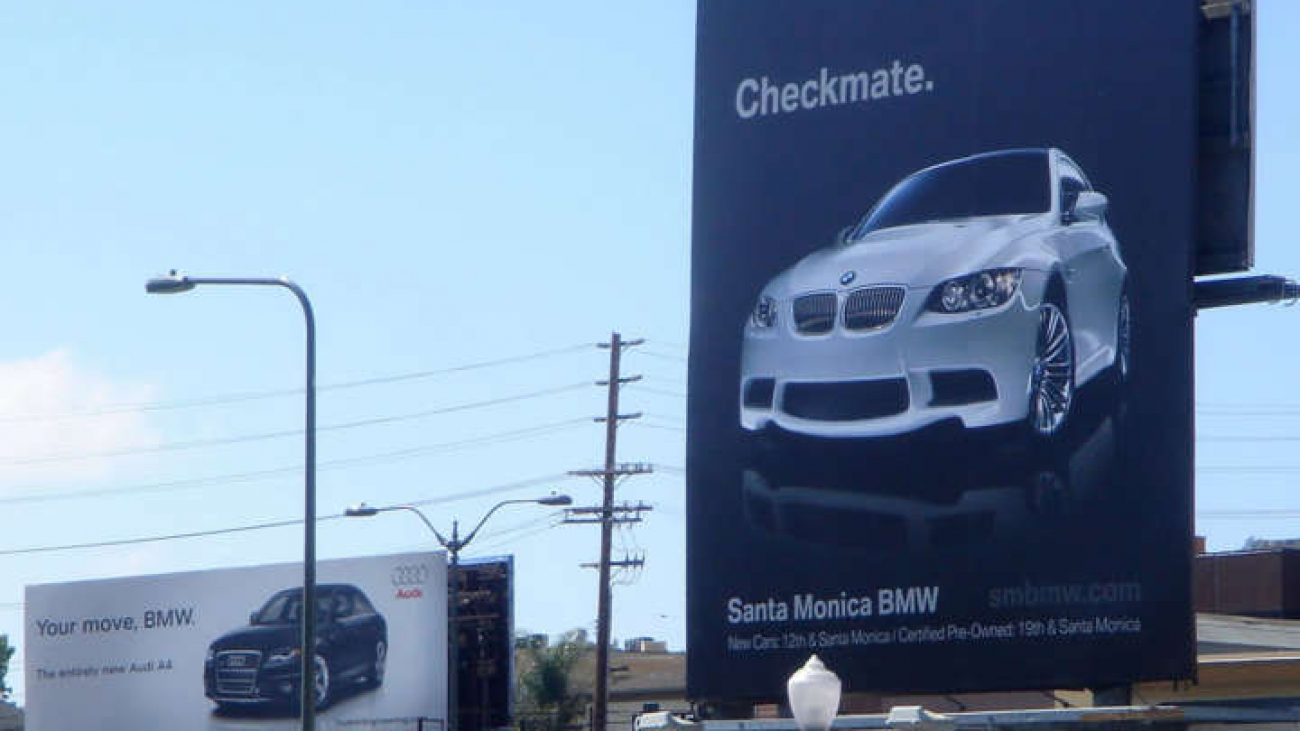There are many great examples of billboard advertising worldwide, but one that captured a lot of media attention was when Audi ran an outdoor campaign that was constructed on a busy highway promoting the Audi A4, with a headline that read “Your move, BMW”. BMW’s response was to construct an even bigger billboard next to it with the headline that simply read, “Checkmate”, with a photo of the M3. Simply brilliant!
The unique power of those billboard ads (and indeed, all billboards) lies in their tactile nature. Unlike some mediums such as TV or radio ads, which can often seem ethereal or ‘not real’, billboards on the other hand are physical structures that are part of the environment and our everyday lives, which constitute a part of our cultural landscape.
Here are some of the advantages and disadvantages and how to utilise them more effectively:
Some Interesting Stats:
- 4 in 5 people notice billboards. (Nielsen CMV 2013; Driver Engagement Study)
- 71% of believe Billboards are very effective at reaching them with advertising messages when they drive. (Nielsen CMV 2013; Driver Engagement Study)
- 72% of billboard viewers actually shop on their way home and 68% make shopping decisions while in the car. (Arbitron National In-Car Study)
- 32% of drivers visited a business they saw advertised on a billboard sometime during the same week. (Arbitron National In-Car Study)
Advantages
- Visibility
One of the biggest advantages of billboard marketing is its visibility. When placed in high-traffic areas such as busy highways or streets, you are guaranteed to get a high level of exposure to broad demographic of people. If the billboard is located in an area that is part of someone’s daily commute, there will be even more exposure to that person on a daily basis. - Opportunity for Creative use
Most of the time, billboards are usually created with the same formula – a big picture with a headline. There is a large opportunity for businesses to stand out from the crowd by fully utilising the medium in ways that other businesses are not. Incorporating the surrounding environment into your billboard ad can turn it from something basic into something that people will not forget.
- Targeted Locations
Have you ever felt hungry while driving along a boring highway and then suddenly seen a billboard reading “McDonalds, 10 min ahead”? Most people would respond immediately by buying the food there and then. This is a benefit that billboard advertising has over other mediums. In many situations, the billboard can be positioned to display a product/service right next to the establishment that sells it. This takes advantage of people’s desires ‘in the moment’ and allows them to act on impulse with convenience.
Disadvantages
- Messages must be quick and to the point
Because billboards are normally placed in high-traffic areas, they can only grab the attention of viewers for a short amount of time. Everything is competing for attention, so you better get your message across quickly if you want to engage your audience. This is where strong creativity comes into play – doing something that is memorable will result in more audience engagement.
- Outside forces
Billboards are out in the open, which means they are subject to rain, heat, cold and wind. In addition to this, they can also be subjected to vandalism. This is a factor that must be taken into consideration when choosing a location for a billboard. It is not favourable to your message or your brand if the billboard looks weathered or has been vandalised.
- Price
The pricing of billboards is heavily dependent on the location. High-traffic locations (which yield higher visibility) can be quite expensive and may not always be the most cost-effective way to get your message to your audience.
Billboards are still very much a viable medium for advertising. They provide advertisers and businesses with the opportunity to create eye-catching and engaging ads in the physical environment unlike any other forms of advertising.



